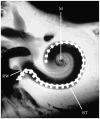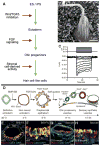Sound strategies for hearing restoration
- PMID: 24812404
- PMCID: PMC4148779
- DOI: 10.1126/science.1241062
Sound strategies for hearing restoration
Abstract
Hearing loss is the most common sensory deficit in humans, with some estimates suggesting up to 300 million affected individuals worldwide. Both environmental and genetic factors contribute to hearing loss and can cause death of sensory cells and neurons. Because these cells do not regenerate, the damage tends to accumulate, leading to profound deafness. Several biological strategies to restore auditory function are currently under investigation. Owing to the success of cochlear implants, which offer partial recovery of auditory function for some profoundly deaf patients, potential biological therapies must extend hearing restoration to include greater auditory acuity and larger patient populations. Here, we review the latest gene, stem-cell, and molecular strategies for restoring auditory function in animal models and the prospects for translating these approaches into viable clinical therapies.
Figures




References
-
- Holt JR, et al. A chemical-genetic strategy implicates myosin-1c in adaptation by hair cells. Cell. 2002;108:371–381. - PubMed
Publication types
MeSH terms
Grants and funding
LinkOut - more resources
Full Text Sources
Other Literature Sources
Medical

